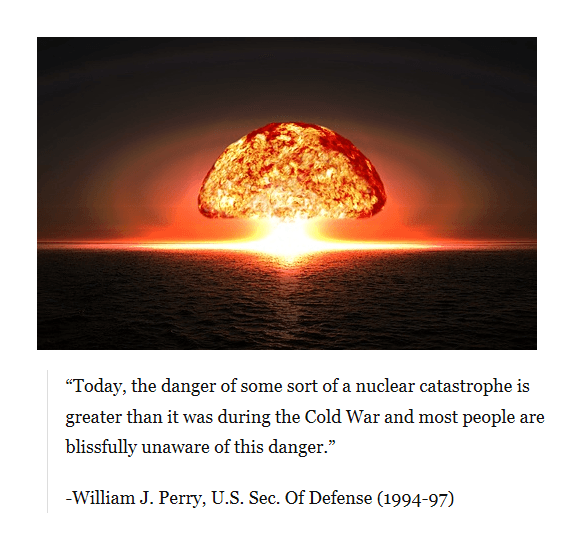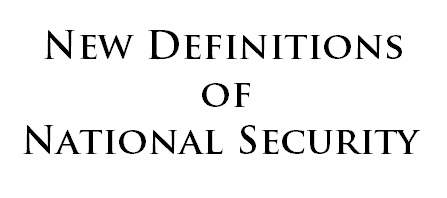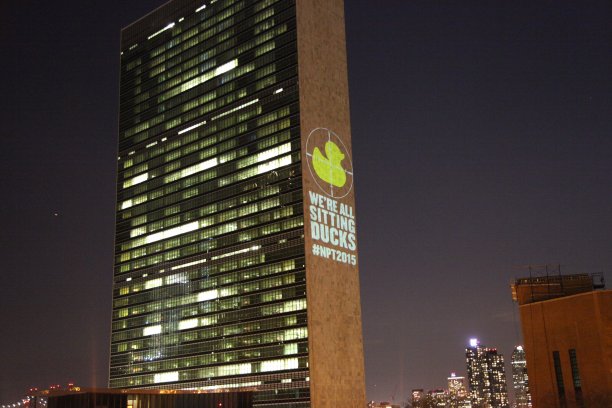Nuclear Proliferation
2017/2016
August
The US President & Nuclear Codes
- James R. Clapper Jr., former director of US national intelligence, questioned President Trump’s fitness for office following the president's speech in Phoenix on Tuesday, August 22.
- “I really question his ability to be — his fitness to be — in this office... I also am beginning to wonder about his motivation for it — maybe he is looking for a way out.”
- Clapper continued after watching Trump’s speech that he is worried about the president’s access to nuclear codes.
- “In a fit of pique he decides to do something about Kim Jong Un, there’s actually very little to stop him,” Clapper said, referencing the US president and North Korean leader.
- “The whole system is built to ensure rapid response if necessary. So there’s very little in the way of controls over exercising a nuclear option, which is pretty damn scary.”
Nuclear Issues / Cold War 2.0
● New Arms Race Qua Old Arms Race
● At the UN: Abolish Nuclear Weapons
- ············································································································
○ ○ ○ ○ ○ ○
2015/2014
Escalation, Echoes of Assured Destruction
● http://strategicdemands.com/new-nuclear-arms-race/
● http://strategicdemands.com/npt-treaty-at-risk/
● http://strategicdemands.com/blip_on_the_screen/
○
Going BZhRK, Looking Backward, Looking Forward
http://strategicdemands.com/going_bzhrk/
○ ○ ○ ○ ○ ○ ○ ○ ○ ○ ○ ○ ○ ○ ○ ○ ○ ○ ○ ○ ○
● http://www.globalzero.org/get-the-facts/nuclear-risk-reduction
GLOBAL NUCLEAR RISK REDUCTION
As world leaders descended on the United Nations in New York for the 2015 Non-Proliferation Treaty (NPT) Review Conference, the Global Zero Commission on Nuclear Risk Reduction — led by former U.S. Vice Chairman of the Joint Chiefs of Staff General James E. Cartwright and comprised of international military experts — issued a bold call for ending the Cold War-era practice of keeping nuclear weapons on hair-trigger alert.
● "Hair-Trigger" Update (2017) -- http://strategicdemands.com/nuclear-hair-trigger
The Commission's extensive report calls for (1) an urgent agreement between the United States and Russia to immediately eliminate "launch-on-warning from their operational strategy, and to initiate a phased stand down of their high-alert strategic forces, beginning with taking 20% of both countries' nuclear forces off launch-ready alert within one year and 100% within 10 years; and (2) a longer-term global agreement requiring all nuclear weapons countries to refrain from putting nuclear weapons on high alert.
_ _ _ _ _ _ _ _ _
NY TIMES Opinion Pages | OP-ED
How to Avert a Nuclear War
By JAMES E. CARTWRIGHT and VLADIMIR DVORKIN
April 2015
We find ourselves in an increasingly risky strategic environment. The Ukrainian crisis has threatened the stability of relations between Russia and the West, including the nuclear dimension — as became apparent last month when it was reported that Russian defense officials had advised President Vladimir V. Putin to consider placing Russia’s nuclear arsenal on alert during last year’s crisis in Crimea.
Diplomatic efforts have done little to ease the new nuclear tension. This makes it all the more critical for Russia and the United States to talk, to relieve the pressures to “use or lose” nuclear forces during a crisis and minimize the risk of a mistaken launch.
The fact is that we are still living with the nuclear-strike doctrine of the Cold War, which dictated three strategic options: first strike, launch on warning and post-attack retaliation.
There is no reason to believe that Russia and the United States have discarded these options, as long as the architecture of “mutually assured destruction” remains intact.
For either side, the decision to launch on warning — in an attempt to fire one’s nuclear missiles before they are destroyed — would be made on the basis of information from early-warning satellites and ground radar. Given the 15- to 30-minute flight times of strategic missiles, a decision to launch after an alert of an apparent attack must be made in minutes.
This is therefore the riskiest scenario, since provocations or malfunctions can trigger a global catastrophe. Since computer-based information systems have been in place, the likelihood of such errors has been minimized. But the emergence of cyberwarfare threats has increased the potential for false alerts in early-warning systems. The possibility of an error cannot be ruled out.
American officials have usually played down the launch-on-warning option. They have argued instead for the advantages of post-attack retaliation, which would allow more time to analyze the situation and make an intelligent decision. Neither the Soviet Union nor Russia ever stated explicitly that it would pursue a similar strategy, but an emphasis on mobile missile launchers and strategic submarines continues to imply a similar reliance on an ability to absorb an attack and carry out retaliatory strikes.
Today, however, Russia’s early warning system is compromised. The last of the satellites that would have detected missile launches from American territory and submarines in the past stopped functioning last fall. This has raised questions about Russia’s very ability to carry out launch-on-warning attacks.
Partly to compensate for the loss of its space-based system, Russia has deployed prefabricated radar units that can be set up quickly along its borders. Some of these are already operational; some are still being tested. Unlike satellite networks, radar can provide accurate information about the scale and targeting of a missile attack — but only once a missile has entered its vicinity, which would most likely be 10 to 15 minutes after launch.
The upside of radar reporting is more information. The downside of having to wait is that it cuts the time for deciding whether to launch on warning. That in turn increases the likelihood of mistaken retaliation. For a submarine missile fired from the Norwegian Sea, Russia’s radar network would give its nuclear decision makers just 10 minutes to respond. America’s early warning systems can be expected to provide about twice as much time.
Clearly, for either side, these timelines are very compressed and the opportunities for ill-considered decisions very real. Launch-on-warning puts enormous strain on the nuclear chains of command in both countries.
In theory, no sensible head of state would authorize a launch-on-warning strike after receiving information that just one missile, or a small number of missiles, were inbound, on the assumption that this was not an intentional, full-scale attack. But the launch-on-warning doctrine still rules in both Russia and the United States — in which case the risk, however small, of cataclysmic error remains.
This risk should motivate the presidents of Russia and the United States to decide in tandem to eliminate the launch-on-warning concept from their nuclear strategies. They should reinstitute military-to-military talks, which were suspended over the Ukraine crisis, to pursue this stand-down as an urgent priority. (A joint decision on this would not destabilize nuclear deterrence: Both countries still have nuclear forces designed to withstand a first-strike attack, guaranteeing retaliatory strikes.)
To reinforce this accord, both countries should refrain from conducting military exercises that involve practicing missile launches based on information from early warning systems. Even if this restraint cannot yet be fully verified, it would be a valuable contribution to strategic stability — and, of course, to preventing an inadvertent nuclear war. This would be a positive step ahead of the 'Non-Proliferation Treaty Review Conference' that the United Nations will host later this month.
Detailed verification measures can come later, once better Russian-American relations are restored. The technical implementation of a decision to abandon the launch-on-warning concept would fall within the framework of the New Start treaty. A phased reduction of the combat readiness of the strategic nuclear forces would provide a safer time buffer for nuclear decision making.'
In periods of heightened tensions and reduced decision times, the likelihood of human and technical error in control systems increases.
Launch-on-warning is a relic of Cold War strategy whose risk today far exceeds its value.
Our leaders urgently need to talk and, we hope, agree to scrap this obsolete protocol before a devastating error occurs.
◊




